
Stamps printed in pale or light colours were introduced in 1941 as a wartime measure to provide a more economic use of ink and to reduce wear on the cylinders. Rolls containing these stamps were issued in 1942. No (LP) rolls, and initially no (KN) rolls, were produced as 1940 changes in postal rates had reduced the demand and there was sufficient stock of earlier rolls in hand. There was no change of colour for the 6d stamp, hence no (J) rolls are listed in Pale Colours. Some rolls were overprinted “GVI”, presumably using up old leader stock.
Leaders were also subject to wartime measures, coloured leaders were replaced by uncoloured or buff ones. Colour was reintroduced after the war, thus the Pale Colours period spans three distinct issues: dull colours on buff, buff, and bright colors on white.
First Issue

| B | 1d | 960 | £4 | Lower End | Red/Buff | c |
| C | 3d | 960 | £12 | Lower End | Sage-Green | 20 * |
| D | ½d | 960 | £2 | Lower End | Green/Buff | c |
| E | 1d | 480 | £2 | Lower End | Red/Buff | c |
| F | 2½d | 960 | £10 | Lower End | Blue/Buff | c |
| G | ½d | 480 | £1 | Lower End | Green/Buff | c |
| M | 2½d | 480 | £5 | Left Side | Blue/Buff | csw † |
| O | 1d | 480 | £2 | Left Side | Red/Buff | csw |
| Q | 2d | 960 | £8 | Lower End | Yellow/Buff | 20 |
| R | 2d | 480 | £4 | Top End | Orange ‡ | 20 * |
| S | 3d | 480 | £6 | Left Side | Sage-Green | 12 |
| T | 2d | 480 | £4 | Left Side | Yellow/Buff | csw |
| W | ½d | 960 | £2 | Lower End | Green/Buff | c |
| X | 1d | 960 | £4 | Lower End | Red/Buff | c |
| Y | ½d | 1,920 | £4 | Lower End | Green/Buff | c |
| Z | 1d | 1,920 | £8 | Lower End | Red/Buff | c |
c: continuous csw: continuous sideways 12/20: strips
* overprinted “GVI” to the right of the printed panel.
† with no bands of cross-hatching, then three bands printed in black.
‡ orange/white with “GVI” not listed by Langston & Corless,
then yellow/buff without overprint.
Second Issue
The second issue of rolls had buff leaders, most with bands of cross-hatching. The year of issue is not recorded, but likely towards the end of the war.

| B | 1d | 960 | £4 | Lower End | Buff *4 | c † |
| C | 3d | 960 | £12 | Lower End | Buff *4 | 20 |
| E | 1d | 480 | £2 | Lower End | Buff *1 | c |
| F | 2½d | 960 | £10 | Lower End | Buff *4 | c |
| M | 2½d | 480 | £5 | Left Side | Buff | csw |
| O | 1d | 480 | £2 | Left Side | Buff *3 | csw ‡ |
| S | 3d | 480 | £6 | Left Side | Buff | 12 |
| T | 2d | 480 | £4 | Left Side | Buff | csw |
| X | 1d | 960 | £4 | Lower End | Buff *6 | c |
| Z | 1d | 1,920 | £8 | Lower End | Buff *7 | c |
c: continuous csw: continuous sideways 12/20: strips
*n with ‘n’ bands of cross-hatching printed in red (1d), blue (2½d), or violet (3d).
† with bands of cross-hatching, then no bands.
‡ with bands of cross-hatching, then no bands, then green/buff paper printed either side.
Third Issue
The third issue of rolls for endways delivery had perforated leaders in bright colours on white paper with a Harrison watermark, either upright or inverted across the leader. No leaders for sideways delivery rolls had watermarks or were perforated.

Perforated gauge 14 with watermark “Harrison & Sons, London” as seen from the front.
The Post Office introduced a 2d vending machine in Mar 1949 (using two 1d coins, (V) rolls), and a 2½d counter machine in Nov 1949 (not coin operated but paid over the counter, (U) rolls).
| U | 2½d | 1,920 | £20 | Lower End | Blue/White | c |
| V | 2d | 960 | £8 | Lower End | Orange/White | 20 c † |
† Langston & Corless state that (V) rolls were made from sheet stamps; however, Post Office records show that continuous 2d pale orange endways rolls were issued in Mar 1949.
| B | 1d | 960 | £4 | Lower End | Red/White | c |
| E | 1d | 480 | £2 | Lower End | Red/White | c |
| F | 2½d | 960 | £10 | Lower End | Blue/White | c |
| K | 1½d | 960 | £6 | Lower End | Buff | 20 † |
| N | 1½d | 480 | £3 | Left Side | Buff | 12 |
| Q | 2d | 960 | £8 | Lower End | Orange/White | 20 |
| R | 2d | 480 | £4 | Top End | Orange/White | 20 |
| W | ½d | 960 | £2 | Lower End | Green/White | c |
| X | 1d | 960 | £4 | Lower End | Red/White | c |
| Y | ½d | 1,920 | £4 | Lower End | Green/White | c |
| Z | 1d | 1,920 | £8 | Lower End | Red/White | c |
c: continuous csw: continuous sideways 12/20: strips
† not listed by Langston & Corless.
Stamp Vending Machines
Rolls for use in Post Office vending machines (GEWXYZVU) have 480, 960 or 1,920 stamps wound lengthways, facing inwards, onto ¾” diameter cores, for delivery lower end first.
First issue 1942:
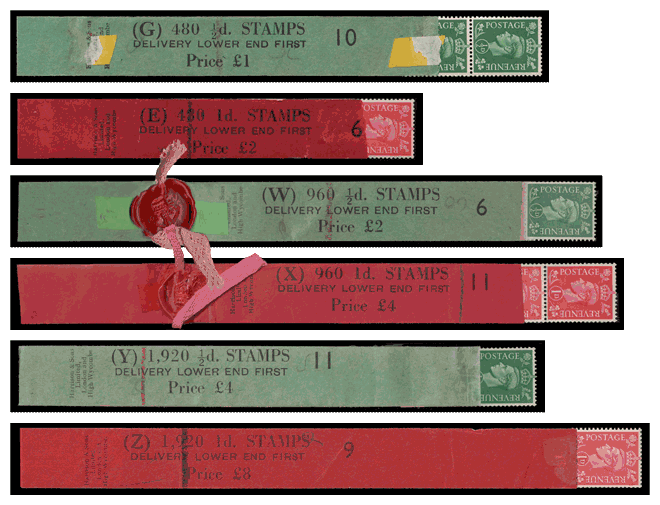
Second issue c.1945:
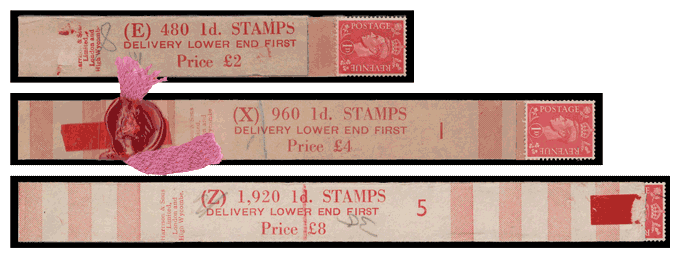
Third issue 1950:
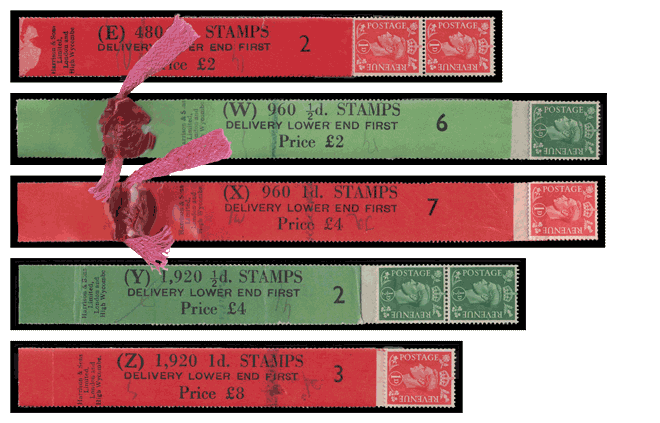
POKO Affixing Machines
Rolls for use in POKO affixing machines (DBKQFC) have 960 stamps wound lengthways, facing outwards, onto 1¼” diameter cores, for delivery lower end first.
First issue 1942:
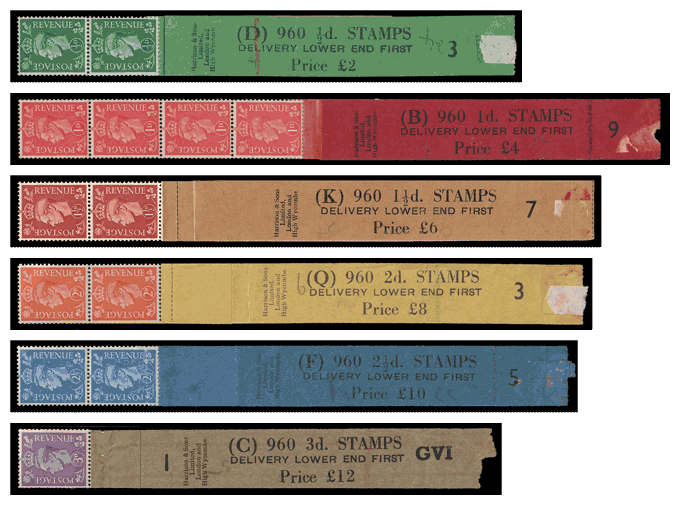
Second issue c.1945:
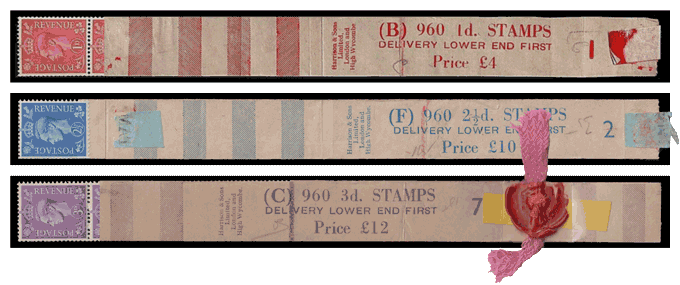
Third issue 1950:
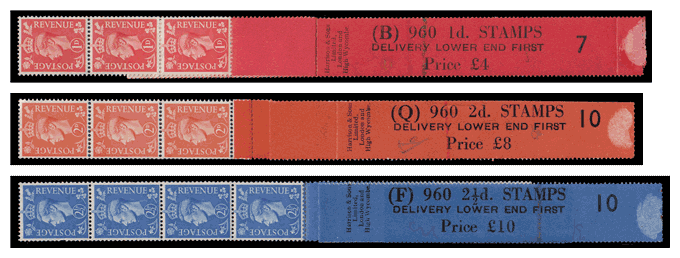
FIXO Affixing Machines
Rolls for use in FIXO affixing machines (R) have 480 stamps wound lengthways, facing outwards, onto ½” diameter cores, for delivery top end first.
First issue 1942:

Third issue 1950:

Multipost Affixing Machines
Rolls for use in Multipost affixing machines (ONTMS) have 480 stamps wound sideways, facing outwards, onto ½” diameter cores, for delivery left side first.
First issue 1942:
Continuously printed, watermark sideways (OTM):
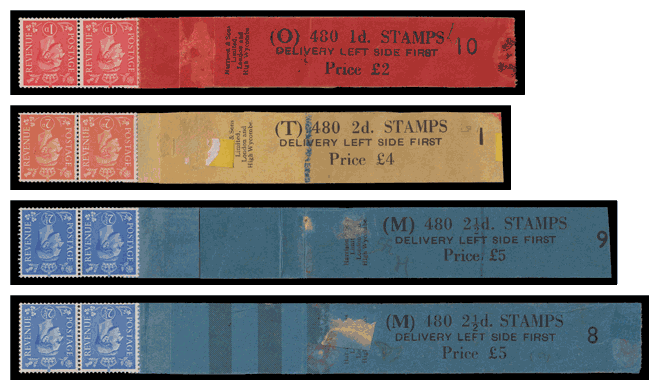
Made from strips of 12, watermark upright (S):

Second issue c.1945:
Continuously printed, watermark sideways (OTM):
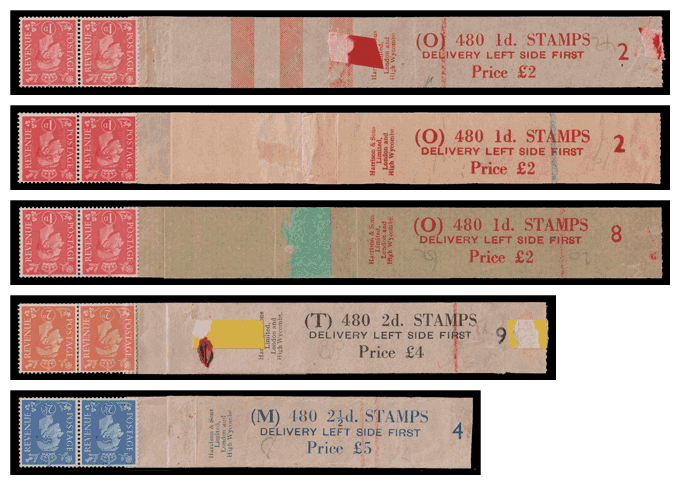
Made from strips of 12, watermark upright (S):

Third issue 1950:
Made from strips of 12, watermark upright (N).

Next: KGVI New Colours